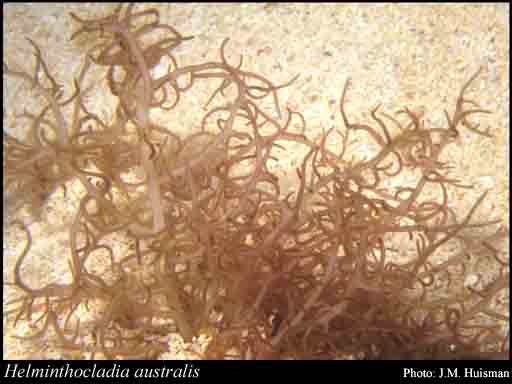- Reference
- Phycol.Austral. 5: Pl. 272 (1863)
- Conservation Code
- Not threatened
- Naturalised Status
- Native to Western Australia
- Name Status
- Current

Scientific Description
Habit and structure. Thallus (gametophyte) brown to purple, 10–40 cm high, with one to many terete, irregularly and usually profusely branched axes 2–10 mm in diameter below, branches (0.5–)1–3 mm in diameter above; older axes and branches sometimes denuded below. Holdfast discoid, 2–5 mm across; epilithic. Structure of a medulla of moderately robust filaments, 8–20 µm in diameter near branch apices, increasing to 30–40 µm in diameter in older parts, and a cortex 100–200(–300) µm broad, of elongate to ovoid (when mature) cells, subdichotomously branched every 1–4 cells in inner cortex, usually at every cell in outer cortex; terminal cells of cortical filaments relatively large, often palisade-like [when mature (25–)30–60 µm long and (10–)15–30 µm in diameter], ovoid to clavate, often markedly larger than the subterminal cells; inner cortical cells in older parts of thallus may equal or even exceed the terminal cells in size; rhodoplasts irregularly stellate, each with a central pyrenoid; hairs often present on subterminal cells near branch apices. Tetrasporophyte unknown.
Reproduction. Sexual thalli dioecious. Carpogonial branches 3-celled, curved, laterally situated on inner cortical cells; carpogonium conical. Zygote dividing more-or-less obliquely, cutting off 2–4 apical segments which initiate the much branched compact gonimoblast, with terminal ovoid carposporangia (10–)15–25 µm long and 6–11 µm in diameter. Carposporophyte within the outer cortex, 100–250 µm across in surface view. Following fertilization the carpogonial branch cells fuse and in the mature carposporophyte a distinct fusion cell is normally present, involving at least the old carpogonial branch cells and usually the basal cells of the gonimoblast. Sterile adjoining cells of adjacent cortical filaments produce new erect filaments which form an involucre around the carposporophyte and appear similar to the cortical filaments but less mature (i.e. the end cells are not enlarged until much later). The abundance of these involucral filaments varies from very few to numerous in different specimens. Spermatangial clusters densely paniculate, borne on scattered subterminal cells of cortical filaments, each cluster comprising 2–4 axial cells bearing radially 1–3 orders of cells; the outermost acting as spermatangial initials and cutting off 1–3 spherical to ovoid spermatangia 1–2 µm in diameter.
Distribution.Exmouth, W. Aust., around southern Australia and Tas., to Coffs Harbour, N.S.W.; Lord Howe I. New Zealand (Bay of Islands to Stewart I.); Japan; South Africa: California.
Habitat. H. australis is a common species in areas of moderate to slight wave action, though patchy in its occurrence.
[After Womersley, Mar. Benthic Fl. Southern Australia IIIA: 90–91 (1994)]
Distribution
- IBRA Regions
- Carnarvon, Geraldton Sandplains, Swan Coastal Plain.
- IBRA Subregions
- Cape Range, Geraldton Hills, Perth.
- IMCRA Regions
- Central West Coast, Leeuwin-Naturaliste.
- Local Government Areas (LGAs)
- Cockburn, Cottesloe, Exmouth, Greater Geraldton, Irwin, Rockingham.